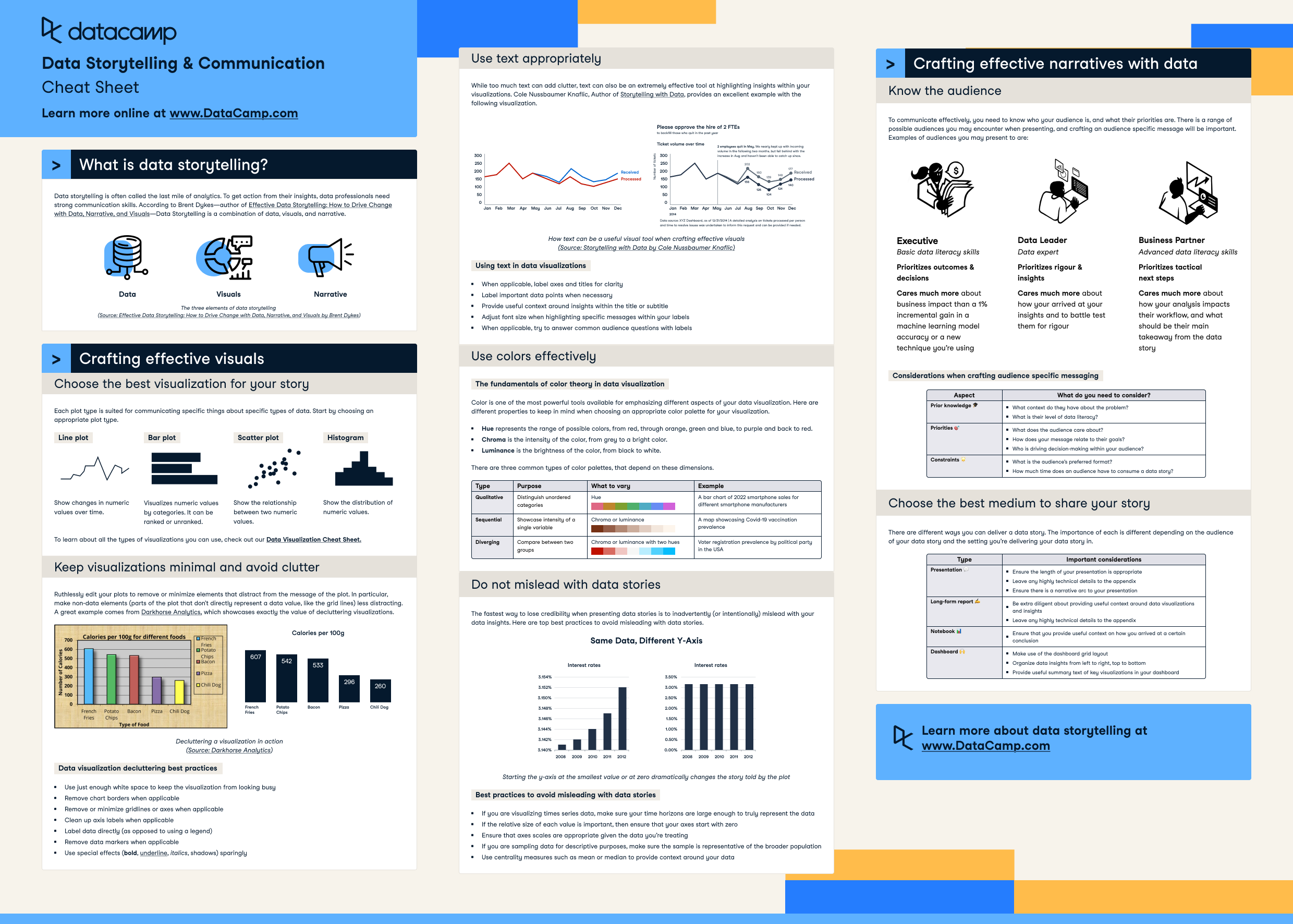Data storytelling is often called the last mile of analytics. Sound communication skills allow data professionals to drive action out of their insights. According to Brent Dykes, Author of Effective Data Storytelling: How to Drive Change with Data, Narrative, and Visuals—Data Storytelling is a combination of data, visuals, and narrative. In this cheat sheet, we outline best practices for delivering data stories to a wide variety of audiences.
Have this cheat sheet at your fingertips
Download PDFCrafting effective visuals
Choose the best visualization for your story
Each plot type is suited for communicating specific things about specific types of data. Start by choosing an appropriate plot type.
- Line plot: Show changes in numeric values over time.
- Bar plot: Visualizes numeric values by categories. It can be ranked or unranked.
- Scatter plot: Show the relationship between two numeric values.
- Histogram: Show the distribution of numeric values.
To learn about all the types of visualizations you can use, check out our Data Visualization Cheat Sheet.
Keep visualizations minimal and avoid clutter
Ruthlessly edit your plots to remove or minimize elements that distract from the message of the plot. In particular, make non-data elements (parts of the plot that don't directly represent a data value, like the grid lines) less distracting. A great example comes from Darkhorse Analytics, which showcases exactly the value of decluttering visualizations.
Data visualization decluttering best practices
- Use just enough white space to keep the visualization from looking busy
- Remove chart borders when applicable
- Remove or minimize grid lines or axes when applicable
- Clean up axis labels when applicable
- Label data directly (as opposed to using a legend)
- Remove data markers when applicable
- Use special effects (bold, underline, italics, shadows) sparingly
Use text appropriately
While too much text can add clutter, text can also be an extremely effective tool at highlighting insights within your visualizations. Cole Nussbaumer Knaflic, Author of Storytelling with Data, provides an excellent example with the following visualization.
Using text in data visualizations
- When applicable, label axes and titles for clarity
- Label important data points when necessary
- Provide useful context around insights within the title or subtitle
- Adjust font size when highlighting specific messages within your labels
- When applicable, try to answer common audience questions with labels
Use colors effectively
The fundamentals of color theory in data visualization
Color is one of the most powerful tools available for emphasizing different aspects of your data visualization. Here are different properties to keep in mind when choosing an appropriate color palette for your visualization.
- Hue represents the range of possible colors, from red, through orange, green and blue, to purple and back to red.
- Chroma is the intensity of the color, from gray to a bright color.
- Luminance is the brightness of the color, from black to white.
There are three common types of color palettes that depend on these dimensions.
| Type | Purpose | Example |
| Qualitative | Distinguish unordered categories | A bar chart of 2022 smartphone sales for different smartphone manufacturers |
| Sequential | Showcase intensity of a single variable | A map showcasing Covid-19 vaccination prevalence |
| Diverging | Compare between two groups | Voter registration prevalence by political party in the USA |
Do not mislead with data stories
The fastest way to lose credibility when presenting data stories is to inadvertently (or intentionally) mislead with your data insights. Here are top best practices to avoid misleading with data stories.
Best practices to avoid misleading with data stories
- If you are visualizing times series data, make sure your time horizons are large enough to truly represent the data
- If the relative size of each value is important, then ensure that your axes start with zero
- Ensure that axes scales are appropriate given the data you re treating
- If you are sampling data for descriptive purposes, make sure the sample is representative of the broader population
- Use centrality measures such as mean or median to provide context around your data
Crafting effective narratives with data
Know the audience
To communicate effectively, you need to know who your audience is, and what their priorities are. There is a range of possible audiences you may encounter when presenting, and crafting an audience-specific message will be important. Examples of audiences you may present to are:
Executive
- Basic data literacy skills
- Prioritizes outcomes & decisions
- Cares much more about business impact than a 1% incremental gain in a machine learning model accuracy or a new technique you re using
Data Leader
- Data expert
- Prioritizes rigor & insights
- Cares much more about how your arrived at your insights and to battle test them for rigor
Business Partner
- Advanced data literacy skills
- Prioritizes tactical next steps
- Cares much more about how your analysis impacts their workflow, and what should be their main takeaway from the data story
Considerations when crafting audience specific messaging
| Aspect | What do you need to consider? |
| Prior knowledge |
|
| Priorities |
|
| Constraints |
|
Choose the best medium to share your story
There are different ways you can deliver a data story. The importance of each is different depending on the audience of your data story and the setting you’re delivering your data story in.
| Type | Important considerations |
| Presentations |
|
| Long-form report |
|
| Notebook |
|
| Dashboard |
|
Learn more about data storytelling at www.DataCamp.com



